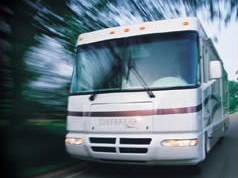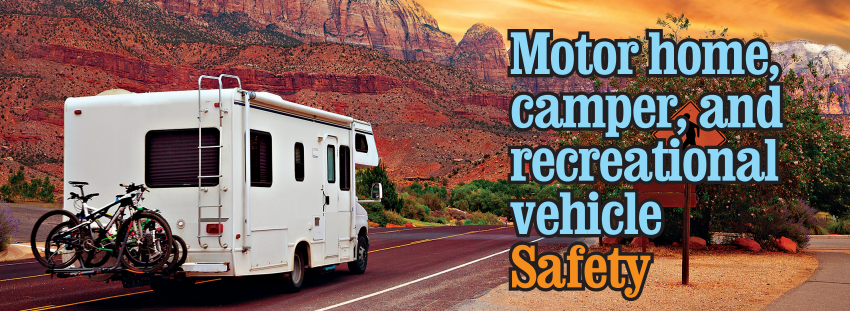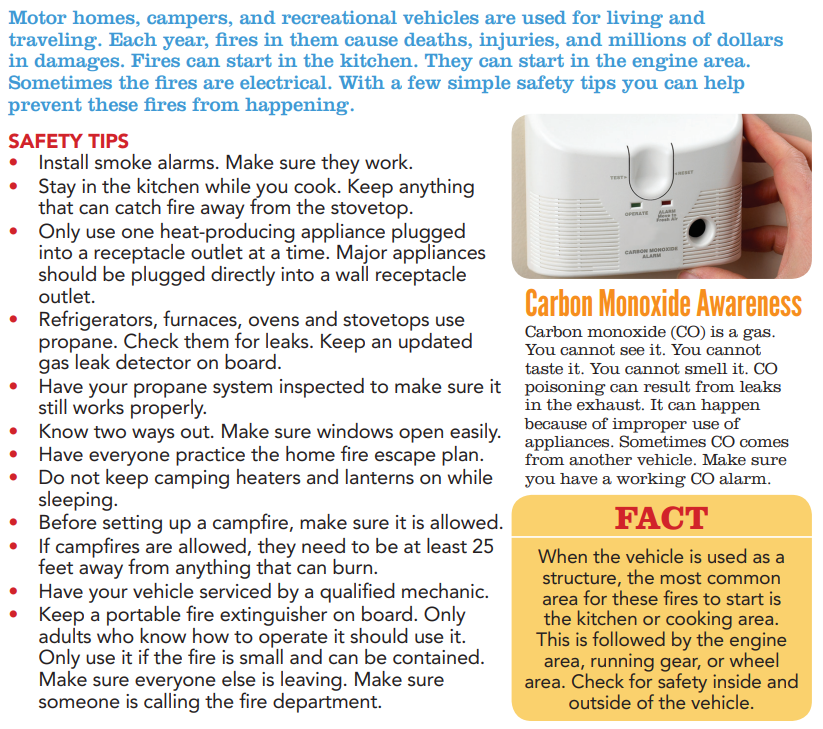 Driving in Weather Conditions
Driving in Weather Conditions
When you are driving your RV, be aware of crosswinds. Crosswinds are caused by the wind blowing against the side of the RV. Sudden crosswinds may cause the RV, especially if it is over-loaded, to suddenly swerve into another lane. If you must drive in windy conditions, be sure to reduce your speed so you have enough time to react.
Recreational vehicle types include the motorhome (classes A, B, B+, and C), travel trailer, fifth wheel trailer, toy hauler, popup trailer, and slide-in camper (which fits in the bed of a pickup truck)
A recreational vehicle normally includes a kitchen, a bathroom, and one or more sleeping facilities. Less commonly found features are a hot tub, a dining room, a desk, and a vanity closet. Most RVs are single-deck; however, double-deck RVs also exist. RVs come in either towable models, like trailers and tent-trailers, or can be self-motorized, like motorhomes. Many have expandable canopies to create a covered outdoor living space. RVs can range from the utilitarian — containing only sleeping quarters and basic cooking facilities — to the luxurious, with features like air conditioning (AC), water heaters, televisions and satellite
Compared to automobile accidents, RV accidents are pretty rare. About 70,000-80,000 accidents involving RVs occur each year. This is significantly lower than crashes involving automobiles. However, RV accidents can sometimes be more dangerous because of the weight and size of RVs


GEICO Insurance reports on Recreational Vehicle (RV) Safety with tips on how to operate your recreational vehicle safely.
Protect your RV and everybody in it by following these tips and the pre-trip checklist
Realize your size.
Many road mishaps occur because of an RV’s additional size and weight. For instance, operators accidentally drive under an overpass without enough clearance because they forget about the additional height. Know your RV’s height, and keep it handy. Also know the clearances of the bridges and tunnels along your route—especially on back roads. A road atlas specifically for RVers or semi drivers can help.
Maintenance is important.
An RV that’s mechanically sound will be less apt to break down. Be meticulous about maintenance. Make a pre-trip checklist, and do an inspection every time you get behind the wheel. Utilize these safety tips to ensure the proper maintenance of your RV:
- Inspect all belts, and hoses for cracking and replace where required
- Check headlights, turn signal, tail lights
- Check your tires for the correct air pressure and sufficient tread depth
- Check any hitch or towing equipment
- Check your fire extinguishers and smoke alarms
- Clean your cooking vent hood to avoid grease fires
- Make sure food is secured safely within kitchen cabinets
- Have a plan if you do break down.
Carry your cell phone and know the emergency numbers to call. Also leave your itinerary with relatives or friends in case of emergency.
Adjust for weather.
Heavy winds, rain, fog, and ice make RV driving treacherous. If possible, plan your trip to avoid bad weather or factor in extra time so you can delay travel if necessary.
Always wear safety belts.
Passengers should be belted in also. Laws don’t require RV’s to have safety belts in all areas where passengers can sit, but it is better to be safe so buckle up!
Most common causes of RV Accidents include:
- Fires that occur from leaking LP gas (propane)
- Tire blowouts: Overloading, under inflated or old tires
- RV awnings and steps: RV outside steps not put away before traveling and not storing awning properly during travel and questionable weather
- Clearance and height driving mistakes: RVs hitting bridges and gas station overhangs
- Overloading: Uneven weight can cause restricted braking and steering
- Slide-Out: Making sure that the slide-outs are retracted before driving away
- Pests, bugs, rodent infestations: When the RV is stored for any period of time, mice, squirrels and many other rodents are well known for chewing on the wires, plastic and rubber lines in the RV
Consumer Reports magazine reports 9 Tips for Safer RV Travel
1. Develop a safety checklist. Consult it before every trip. This includes checking the condition and inflation of your tires, looking under the hood for problems with belts and hoses, checking oil and other fluids, and verifying that all exterior lights and turn signals are working.
2. Stay buckled up. You might look forward to getting up to make a sandwich while traveling. Don’t. Instead, pull over when you or your passengers want to go to the kitchen or bathroom.
3. Be proactive about RV maintenance. Many RVs travel significant distances and are then parked for long periods. The use pattern is quite different from cars, and there can be a temptation to cut corners. Maintain your vehicle according to the schedule recommended by the manufacturer. This will save you in the long run.
4. Replace older RV tires. Regardless of how much wear or use they have, Consumer Reports recommends replacing tires at 10 years old from date of manufacture, or sooner if specified in the vehicle owner’s manual.
5. Add tire pressure monitors. It’s wise to invest in tire pressure monitors that can warn you about problems before they become disasters. There are several products made specifically for RVs, with different levels of specificity (“low” vs. psi readout, for example). The better systems involve fitting a sensor inside the tire, with a remote digital display of tire pressure.
6. Balance the weight in your RV. This will improve handling and reduce tire wear. The RV should be loaded based on weight capacity and distribution, including the weight of towed vehicles or trailers, cargo in the basement storage, and water in the tanks. For loading details specific to your vehicle, refer to the owner’s manual that came with your RV.
7. Secure your belongings. All items should be stowed and secured when the RV is in motion to make sure they don’t move about the interior. This includes items in the cabinets.
8. Practice driving your RV. Operating an RV is very different from driving a car or pickup truck. So it’s important to practice driving. Each type has its own quirks, such as braking distances, roof clearance, and turning radius. Start in an empty parking lot with cones. And ask your retailer about classes.
9. Get a backup camera. If your RV isn’t equipped with a backup camera, add one. And when reversing, have a passenger stand outside with a handheld radio to watch for dangers that could be in your blind zones.
